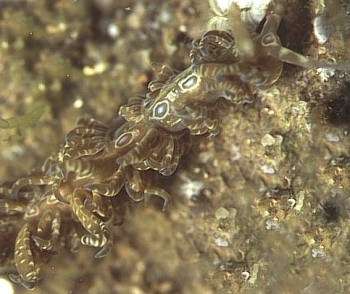
Limenandra fusiformis
(Baba, 1949)
Order: NUDIBRANCHIA
Suborder: AEOLIDINA
Family: Aeolidiidae
DISTRIBUTION
Known only from Japan
PHOTO
Kurosaki, Toyama Bay, Japan, 3m depth, September 13, 1999. Length 60-70 mm. PHOTOS: Shigeru Hayashi.
Cerata described as rounded and 'fusiform', rather than flattened as in many aeolidiids. Rhinophore club with posterior papillae. No papillae on cerata.
Compare with Limenandra nodosa and Limenandra sp. 1.
Reference:
• Baba, K. (1949) Opisthobranchia of Sagami Bay. Iwanami Shoten, Tokyo. 211pp + pls.
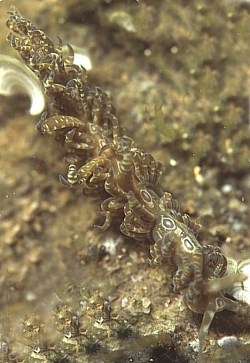
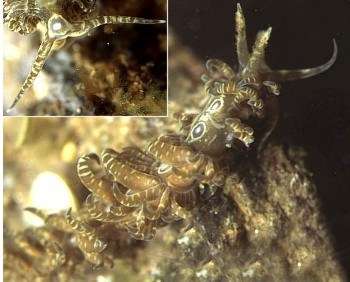
Rudman, W.B., 1999 (September 24) Limenandra fusiformis (Baba, 1949). [In] Sea Slug Forum. Australian Museum, Sydney. Available from http://www.seaslugforum.net/find/limefusi
Related messages
Re: Limenandra fusiformis? from the Philippines
May 26, 2005
From: Erwin Koehler
Dear Bill,
Concerning your question [message #13829]:
Yes, when crawling it looked like jumping - that's why i discovered this well camouflaged animal, there was an unusual movement. Nice to say I discover a sea slug because of the way it was moving...
Regards,
Erwin
erwin@Philippine-Sea-Slugs.com
Koehler, E., 2005 (May 26) Re: Limenandra fusiformis? from the Philippines. [Message in] Sea Slug Forum. Australian Museum, Sydney. Available from http://www.seaslugforum.net/find/13877Thanks Erwin,
It's very interesting. It looks as though we will be able to use this jerking movement as a character to define the genus Limenandra.
Best wishes,
Bill Rudman
Limenandra fusiformis? from the Philippines
May 25, 2005
From: Erwin Koehler
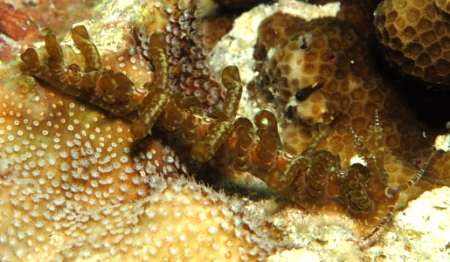
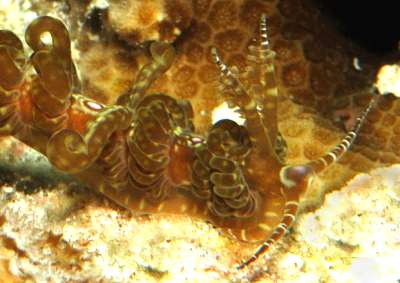
Dear Bill,
I sent you this shot very large, so you can see there are no papillae on the cerata, so I guess this is Limenandra fusiformis.
Locality: Nunez Shoal, Cebu North, Philippines. Depth: 11 m. Length: 44 mm. 05 May 2005. Photographer: Erwin Koehler
Regards Erwin
www.Philippine-Sea-Slugs.com
Erwin@Philippine-Sea-Slugs.com
Koehler, E., 2005 (May 25) Limenandra fusiformis? from the Philippines. [Message in] Sea Slug Forum. Australian Museum, Sydney. Available from http://www.seaslugforum.net/find/13829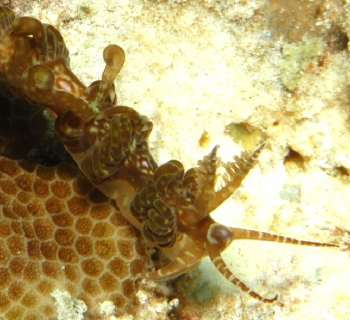
Dear Erwin,
Thanks for these photos. Yes I agree that this fits Baba's description quite well. It is interesting to see that like Limenandra nodosa it also has the concentric rings forming 'targets' down the dorsal midline. From your photo it also seems that the innermost cerata in the most posterior row of each ceratal cluster waves around like in L. nodosa. Can you remember if this animal appeared to 'jerk' along as it crawled, as I have described for that species?
Best wishes,
Bill Rudman
Limenandra fusiformis from the Japan Sea
September 24, 1999
From: Shigeru Hayashi

Dear Bill,
Here is Limenandra fusiformis (Baba, 1949). The Japan Sea which lies between the Asian mainland and the west coast of Japan is partially enclosed and the warmer water fauna from the Pacific east coast is only rarely found in Toyama Bay, on the west coast of Japan.
I collected 2 individuals from 3m water depth in September 13, 1999, Toyama Bay, Kurosaki.
It spawns on the marine algae Sargassum. The body length is 60-70 mm.
We have records of it from: Kurosaki, Toyama Bay on August 27, 1994, Abugashima, Toyama Bay on August 28, 1994 and Huto, Noto Peninsula on August 30, 1998.
Sincerely yours
Shigeru Hayashi
Takaoka Biological Club
Toyama Pref. Japan
jr9dsx@tko.fitweb.or.jp


Dear Shigeru,
This is another interesting animal. There seem to be a number of aeolidiid species with a pattern of concentric rings on the body, especially on the head. As well as the the other species of Limenandra, another species that comes to mind is Spurilla australis.
Another interesting similarity is your mention that Limenandra fusiformis lays its eggs on Sargassum. Spurilla australis is also often found on brown algae, where it feeds on a small sea anemone which appears to live in association with the algae. Do you know what Limenandra fusiformis feeds on?
As with your photos of Elysia abei, it is very interesting to see these photos of a Japanese species for the first time.
Best wishes,
Bill Rudman.
